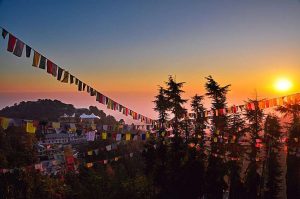
Buddhists in Gujarat, India, are protesting against the removal of the word “Buddhist” from a signboard reading “Relics of a Buddhist past” that stands beside Momai Mata Hindu temple at the Sana Buddhist Caves. This protest is an indicator of growing tensions as local Hindus have increased their control of the cave complex.
Local Hindu residents, including 70-year-old priest Ram Sharan Das, who leads worship at Momai Mata, asserted that the caves were constructed by the mythical warrior Bhima, who appears in the epic Sanskrit text Mahabharata. “It’s our belief that these caves were sculpted more than 5,000 years ago,” said Das. “All this talk of a Buddhist past is imaginary.” (Religion News Service)
Momai Mata is situated within one of the 62 Sana Buddhist Caves. Also known as the Shana Dungar Buddhist Caves, the site is located in Shana Vankiya in Gujarat’s Gir Somnath District.
Local residents claim that neglect of the site has allowed upper-caste Hindus to take over, while perpetuating various myths about the area’s history. For example, one cave has been named Bhimachari and linked to the marriage of the mythical warrior Bhima, although there is no historical evidence to support this.
“Temples dedicated to local Hindu deities have sprouted all over Sana,” said local Buddhist activist Ashish Baudh. “This is a way to erase our Buddhist past.” (Religion News Service)

Similar to other Buddhist caves in India, the Sana caves feature rock carvings that extend across the hillside, as well as rock-cut architecture, stupas, meditation alcoves, and prayer halls. Archaeologists note that the cave complex, recognized as the oldest in western India, was carved to provide shelter for monks during the monsoon season. The oldest carvings have been dated to the second century BCE.
More than six years ago, India’s tourism ministry had proposed promoting Sana and other Buddhist sites in the region, believing that this would draw pilgrims and boost ecotourism. Sana was also included among 13 sites for the Gujarat Buddhist tourism circuit, however, local Buddhist activists expressed concern that the Archaeological Survey of India had not sufficiently safeguarded the caves.
“The government doesn’t want to protect Buddhist sites,” said Nilesh Kathar, a Dalit writer and the author of the book The Buddhist Caves in Saurashtra-Kachchh, which explores the Buddhist ruins in Gujarat’s peninsula region. “These have become strongholds of Hindu chauvinists in the lack of sufficient care.” (Religion News Service)

In September last year, hundreds of volunteers from the civil rights group Swayam Sainik Dal (SSD), advocates of the Buddha’s teachings, marched to the Sana Caves to raise awareness about the site’s conservation.
“Despite their historical significance, these caves have fallen into disrepair and have been subjected to vandalism and encroachment,” said SSD activist Sanjay Shauryavanshi. “The Archaeological Department’s efforts to protect them have been insufficient, with notice boards defaced or removed. Some individuals, motivated by a narrow casteist mentality, have even built temples dedicated to Hindu deities within these Buddhist caves. This disregard for cultural heritage threatens the very existence of these ancient treasures.” (The Mooknayak)
The earliest archaeological evidence of Buddhism in Gujarat dates to the reign of Emperor Ashoka in 268 BCE. The area of Sana is mentioned in the writings of the Chinese scholar-monk Xuanzang, who noted that there were more than 200 monasteries in Gujarat, where thousands of monks studied art, history, culture, and philosophy.
By 27 BCE, Buddhism had begun to spread throughout Gujarat. Archaeological remains and historical records up to 470 CE indicate the development of ornamentatal structures and shelters in the Somnath and Vadnagar areas of Gujarat. Among these, the Sana Buddhist Caves stand out as the most significant.
The recent neglect of the caves poses a serious threat to Gujarat’s rich cultural heritage. Once the heart of the region’s Buddhist culture, these architectural wonders now endure in silent despair.
See more
Sana Buddhist Caves (Original Buddhas)
Neo-Buddhists push back against Hindu claims on ancient cave monasteries in India (Religion News Service)
How the Sacred Sana Buddhist Caves in Gujarat Have Turned into Dens of Vices? (The Mooknayak)
Related news reports from BDG
2,300-Year-Old Buddhist Elephant Statue Unearthed in India
Buddha Head Found amid New Excavation Efforts in Gujarat, India
Ancient Buddhist Structures and Murals Discovered in Madhya Pradesh, India
Thousands of Dalits Embrace Buddhism in Gujarat on Birth Anniversary of Dr. B. R. Ambedkar
Archaeological Survey of India Identifies Buddhist Settlement at Taranga Hills in Gujarat
1,000-Year-Old Buddhist Archaeological Site of Pilak Included in New Tourism Circuit for India
Related features from BDG
Living Dr. Ambedkar’s Vision
An Ambedkarite Buddhist Today
A New Birth: Walking on the Path of Buddhism
Reviving the Dhamma: Ambedkar’s Impact on Empowering the Marginalized through Buddhism
The Tai Situpa, the Ganden Tripa and the Dalai Lama: My Meetings with Great Masters in India














